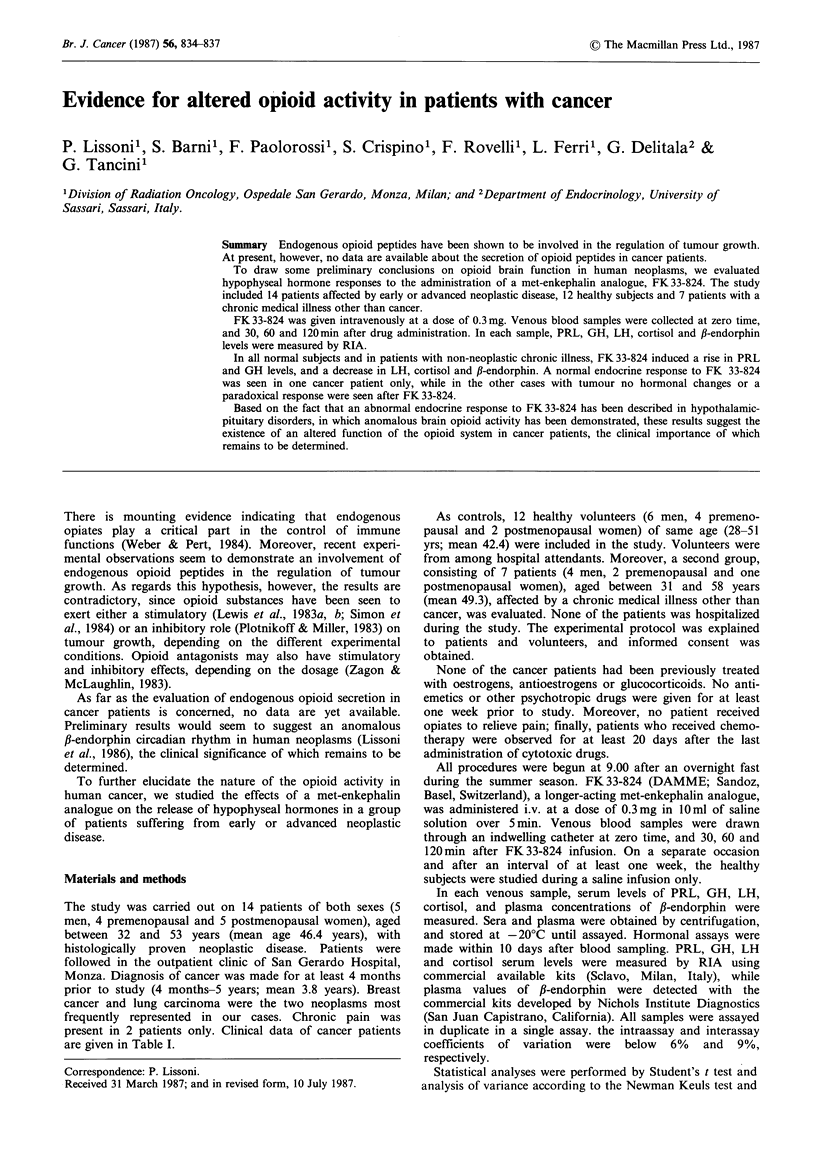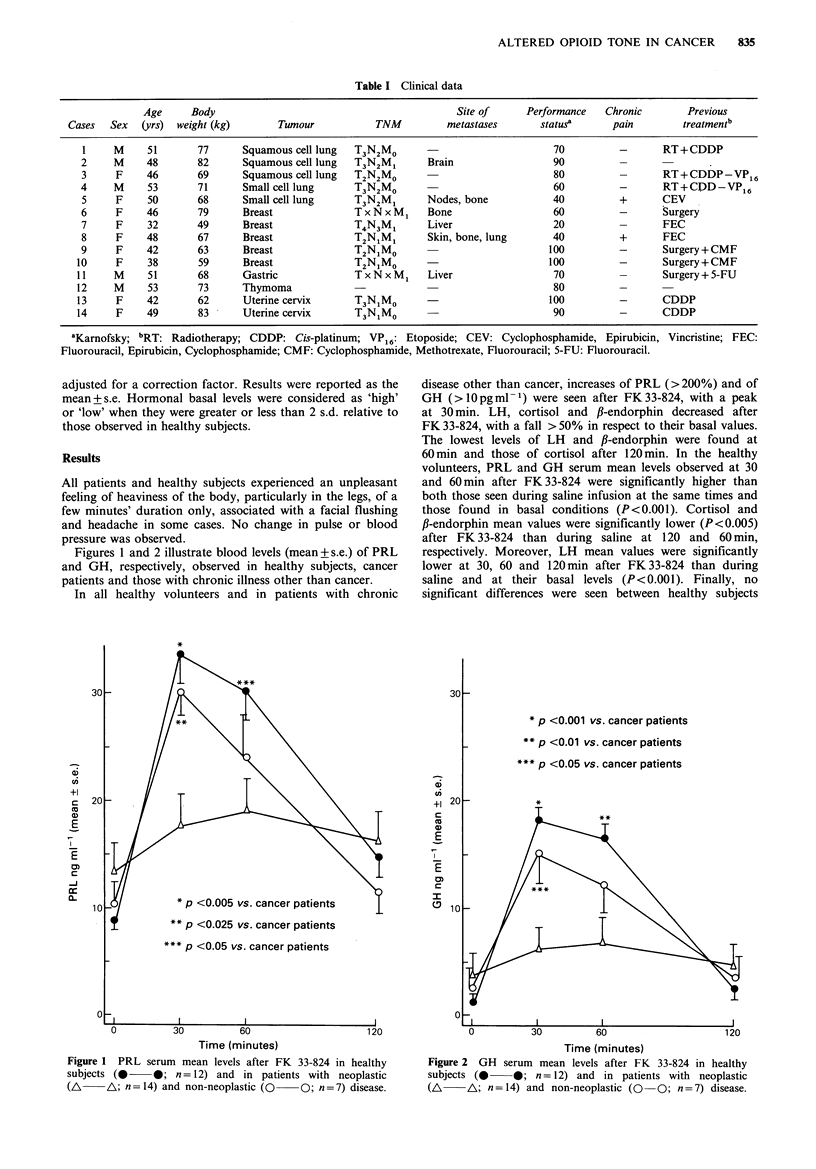Abstract
Endogenous opioid peptides have been shown to be involved in the regulation of tumour growth. At present, however, no data are available about the secretion of opioid peptides in cancer patients. To draw some preliminary conclusions on opioid brain function in human neoplasms, we evaluated hypophyseal hormone responses to the administration of a met-enkephalin analogue, FK 33-824. The study included 14 patients affected by early or advanced neoplastic disease, 12 healthy subjects and 7 patients with a chronic medical illness other than cancer. FK 33-824 was given intravenously at a dose of 0.3 mg. Venous blood samples were collected at zero time, and 30, 60 and 120 min after drug administration. In each sample, PRL, GH, LH, cortisol and beta-endorphin levels were measured by RIA. In all normal subjects and in patients with non-neoplastic chronic illness, FK 33-824 induced a rise in PRL and GH levels, and a decrease in LH, cortisol and beta-endorphin. A normal endocrine response to FK 33-824 was seen in our cancer patient only, while in the other cases with tumour no hormonal changes or a paradoxical response were seen after FK 33-824. Based on the fact that an abnormal endocrine response to FK 33-824 has been described in hypothalamic-pituitary disorders, in which anomalous brain opioid activity has been demonstrated, these results suggest the existence of an altered function of the opioid system in cancer patients, the clinical importance of which remains to be determined.
Full text
PDF



Selected References
These references are in PubMed. This may not be the complete list of references from this article.
- Barni S., Lissoni P., Tancini G., Crispino S., Paolorossi F., Rovelli F., Fumagalli G., Ferri L. Prolactin response to thyrotropin-releasing hormone in early and advanced human breast cancer. Tumori. 1986 Aug 31;72(4):399–403. doi: 10.1177/030089168607200410. [DOI] [PubMed] [Google Scholar]
- De Leo V., Petraglia F., Sardelli S., De Leo M., Genazzani A. R., D'Antona N. Central opioid receptor activity in patients affected by puerperal, idiopathic and tumoral hyperprolactinemia. Gynecol Obstet Invest. 1985;19(3):160–165. doi: 10.1159/000299028. [DOI] [PubMed] [Google Scholar]
- Lewis J. W., Shavit Y., Terman G. W., Gale R. P., Liebeskind J. C. Stress and morphine affect survival of rats challenged with a mammary ascites tumor (MAT 13762B). Nat Immun Cell Growth Regul. 1983;3(1):43–50. [PubMed] [Google Scholar]
- Lewis J. W., Shavit Y., Terman G. W., Nelson L. R., Gale R. P., Liebeskind J. C. Apparent involvement of opioid peptides in stress-induced enhancement of tumor growth. Peptides. 1983 Sep-Oct;4(5):635–638. doi: 10.1016/0196-9781(83)90010-4. [DOI] [PubMed] [Google Scholar]
- Plotnikoff N. P., Miller G. C. Enkephalins as immunomodulators. Int J Immunopharmacol. 1983;5(5):437–441. doi: 10.1016/0192-0561(83)90020-6. [DOI] [PubMed] [Google Scholar]
- Quigley M. E., Sheehan K. L., Casper R. F., Yen S. S. Evidence for an increased opioid inhibition of luteinizing hormone secretion in hyperprolactinemic patients with pituitary microadenoma. J Clin Endocrinol Metab. 1980 Mar;50(3):427–430. doi: 10.1210/jcem-50-3-427. [DOI] [PubMed] [Google Scholar]
- Quigley M. E., Sheehan K. L., Casper R. F., Yen S. S. Evidence for increased dopaminergic and opioid activity in patients with hypothalamic hypogonadotropic amenorrhea. J Clin Endocrinol Metab. 1980 May;50(5):949–954. doi: 10.1210/jcem-50-5-949. [DOI] [PubMed] [Google Scholar]
- Raikhlin N. T., Kvetnoi I. M., Tiurin E. S. Melatonin v syvorotke krovi onkologicheskikh bol'nykh. Klin Med (Mosk) 1980 May;58(5):77–79. [PubMed] [Google Scholar]
- Simon R. H., Arbo T. E., Lundy J. Beta-endorphin injected into the nucleus of the raphe magnus facilitates metastatic tumor growth. Brain Res Bull. 1984 May;12(5):487–491. doi: 10.1016/0361-9230(84)90164-3. [DOI] [PubMed] [Google Scholar]
- Stubbs W. A., Delitala G., Jones A., Jeffcoate W. J., Edwards C. R., Ratter S. J., Besser G. M., Bloom S. R., Alberti K. G. Hormonal and metabolic responses to an enkephalin analogue in normal man. Lancet. 1978 Dec 9;2(8102):1225–1227. doi: 10.1016/s0140-6736(78)92100-1. [DOI] [PubMed] [Google Scholar]
- Viviani S., Santoro A., Ragni G., Bonfante V., Bestetti O., Bonadonna G. Gonadal toxicity after combination chemotherapy for Hodgkin's disease. Comparative results of MOPP vs ABVD. Eur J Cancer Clin Oncol. 1985 May;21(5):601–605. doi: 10.1016/0277-5379(85)90088-4. [DOI] [PubMed] [Google Scholar]
- Willis K. J., London D. R., Ward H. W., Butt W. R., Lynch S. S., Rudd B. T. Recurrent breast cancer treated with the antioestrogen tamoxifen: correlation between hormonal changes and clinical course. Br Med J. 1977 Feb 12;1(6058):425–428. doi: 10.1136/bmj.1.6058.425. [DOI] [PMC free article] [PubMed] [Google Scholar]
- Zagon I. S., McLaughlin P. J. Opioid antagonists inhibit the growth of metastatic murine neuroblastoma. Cancer Lett. 1983 Nov;21(1):89–94. doi: 10.1016/0304-3835(83)90087-3. [DOI] [PubMed] [Google Scholar]


